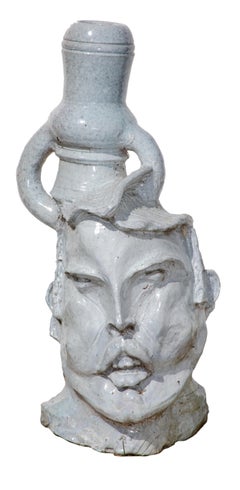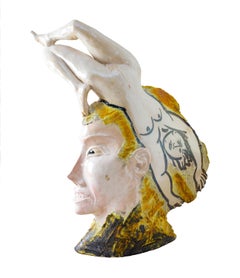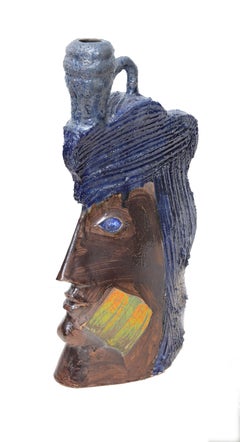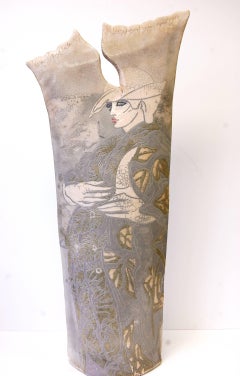Steven Kemenyffy Art
to
1
2
Overall Width
to
Overall Height
to
3
2
1
3
2
1
1
1
1
1
1
1
3
3
9,475
2,687
1,375
1,358
3
Artist: Steven Kemenyffy
Rush Limbaugh (hair parted in center, mouth open)
By Steven Kemenyffy
Located in Milwaukee, WI
31" in height roughly 12-15" wide
Ceramic
Steven Kemenyffy (born 1943) is an American ceramic artist living and working in Pennsylvania. He is most recognized for his contributions to the development of the American ceramic raku tradition. He has served as a Professor of Ceramic Art at Edinboro University of Pennsylvania (formerly Edinboro State College) since 1969. He Has retired from teaching, but continues to produce artwork at his home studio in McKean, Pennsylvania. Kemenyffy is often characterized in regard to his contributions to American experimental ceramics of the late 1960s and early 1970s. More specifically, Kemenyffy’s contributions to American raku techniques are often cited. Kemenyffy has stated that his interest in raku came out of practical considerations: “We [Steven and Susan] were doing a variety of workshops in a variety of different media. Raku was always an official way of making pieces in a short period of time…In raku it seems to compress all the firings into one.” Kemenyffy, himself, describes his early work as “Biomorphic forms alluding to old ceramic traditions such as tiles, vases, and containers.” These works were often in excess of six feet tall and many times included mixed media elements. In 1974, Kemenyffy wrote about the work he was producing; “For several years now, my work has dealt with certain formal considerations. Chief among these is using clay in such a way as to crystallize the moment and permanentize the impermanent. These have been among the primary concerns of all potters since the earliest times.” Today, Kemenyffy continues his pursuit of biomorphic imagery and themes. He writes, “Personally I am most challenged by the business of transforming porous organics into porcelain.” For much of Kemenyffy’s career, he has worked in tandem with his wife, Susan Hale Kemenyffy. In 1987 Susan stated about their collaborative works: “Steven is the [sculptor], I am the drawer. These works would not exist if it weren’t for the sculpture; if it weren’t for the clay. The clay entity comes first and my drawings come second.” James Paul Thompson further clarifies this relationship (as observed in 1987): “Steven Kemenyffy uses patterns as a point of departure for his work, while Susan Kemenyffy...
Category
1990s Steven Kemenyffy Art
Materials
Ceramic
'Can't Get Her Off My Mind' Ceramic Sculpture
By Steven Kemenyffy
Located in Milwaukee, WI
"Can't Get Her Off My Mind" is an original ceramic sculpture created by Steven Kemenyffy.
43"x30"x14"
Ceramic
Steven Kemenyffy (born 1943) is an American ceramic artist living and working in Pennsylvania. He is most recognized for his contributions to the development of the American ceramic raku tradition. He has served as a Professor of Ceramic Art at Edinboro University of Pennsylvania (formerly Edinboro State College) since 1969. He Has retired from teaching, but continues to produce artwork at his home studio in McKean, Pennsylvania. Kemenyffy is often characterized in regard to his contributions to American experimental ceramics of the late 1960s and early 1970s. More specifically, Kemenyffy’s contributions to American raku techniques are often cited. Kemenyffy has stated that his interest in raku came out of practical considerations: “We [Steven and Susan] were doing a variety of workshops in a variety of different media. Raku was always an official way of making pieces in a short period of time…In raku it seems to compress all the firings into one.” Kemenyffy, himself, describes his early work as “Biomorphic forms alluding to old ceramic traditions such as tiles, vases, and containers.” These works were often in excess of six feet tall and many times included mixed media elements. In 1974, Kemenyffy wrote about the work he was producing; “For several years now, my work has dealt with certain formal considerations. Chief among these is using clay in such a way as to crystallize the moment and permanentize the impermanent. These have been among the primary concerns of all potters since the earliest times.” Today, Kemenyffy continues his pursuit of biomorphic imagery and themes. He writes, “Personally I am most challenged by the business of transforming porous organics into porcelain.” For much of Kemenyffy’s career, he has worked in tandem with his wife, Susan Hale Kemenyffy. In 1987 Susan stated about their collaborative works: “Steven is the [sculptor], I am the drawer. These works would not exist if it weren’t for the sculpture; if it weren’t for the clay. The clay entity comes first and my drawings come second.” James Paul Thompson further clarifies this relationship (as observed in 1987): “Steven Kemenyffy uses patterns as a point of departure for his work, while Susan Kemenyffy...
Category
1980s Steven Kemenyffy Art
Materials
Ceramic
'History of Pottery, Africa' Ceramic Sculpture
By Steven Kemenyffy
Located in Milwaukee, WI
41x25x10"
Ceramic
Steven Kemenyffy (born 1943) is an American ceramic artist living and working in Pennsylvania. He is most recognized for his contributions to the development of the American ceramic raku tradition. He has served as a Professor of Ceramic Art at Edinboro University of Pennsylvania (formerly Edinboro State College) since 1969. He Has retired from teaching, but continues to produce artwork at his home studio in McKean, Pennsylvania. Kemenyffy is often characterized in regard to his contributions to American experimental ceramics of the late 1960s and early 1970s. More specifically, Kemenyffy’s contributions to American raku techniques are often cited. Kemenyffy has stated that his interest in raku came out of practical considerations: “We [Steven and Susan] were doing a variety of workshops in a variety of different media. Raku was always an official way of making pieces in a short period of time…In raku it seems to compress all the firings into one.” Kemenyffy, himself, describes his early work as “Biomorphic forms alluding to old ceramic traditions such as tiles, vases, and containers.” These works were often in excess of six feet tall and many times included mixed media elements. In 1974, Kemenyffy wrote about the work he was producing; “For several years now, my work has dealt with certain formal considerations. Chief among these is using clay in such a way as to crystallize the moment and permanentize the impermanent. These have been among the primary concerns of all potters since the earliest times.” Today, Kemenyffy continues his pursuit of biomorphic imagery and themes. He writes, “Personally I am most challenged by the business of transforming porous organics into porcelain.” For much of Kemenyffy’s career, he has worked in tandem with his wife, Susan Hale Kemenyffy. In 1987 Susan stated about their collaborative works: “Steven is the [sculptor], I am the drawer. These works would not exist if it weren’t for the sculpture; if it weren’t for the clay. The clay entity comes first and my drawings come second.” James Paul Thompson further clarifies this relationship (as observed in 1987): “Steven Kemenyffy uses patterns as a point of departure for his work, while Susan Kemenyffy...
Category
1980s Steven Kemenyffy Art
Materials
Ceramic
Related Items
Yellow Swimmer 2 Large - Handmade Modern Glazed Ceramics Sculpture, Man Portrait
By Tomasz Bielak
Located in Salzburg, AT
The sculpture is signed below, inside
Tomasz Bielak born in Lublin in 1967. He graduated of The Academy of Fine Arts, Painting and Graphics Design Department in Gdańsk, in 1994....
Category
2010s Contemporary Steven Kemenyffy Art
Materials
Ceramic, Glaze
$2,004
H 9.45 in W 9.45 in D 7.49 in
Mom Rat With Babies - Unique Handmade Glazed Ceramics Sculpture, Animals
By Monika Zadurska-Bielak
Located in Salzburg, AT
The sculpture is signed below.
Monika Zadurska-Bielak, Graduated from the studio of Prof. Franciszek Duszeńko at the Faculty of Sculpture of the Acade...
Category
2010s Contemporary Steven Kemenyffy Art
Materials
Ceramic
Monika Zadurska-BielakMom Rat With Babies - Unique Handmade Glazed Ceramics Sculpture, Animals, 2020
$707
H 5.91 in W 2.76 in D 3.15 in
Women figure on a pedestal Porcelain, silver, h 20 cm
By Ilona Romule
Located in Riga, LV
Women figure on a pedestal
Porcelain, silver, h 20 cm
by Ilona Romule, leading sculptor in Latvia
The "Women Figure on a Pedestal" is a decorative art p...
Category
2010s Contemporary Steven Kemenyffy Art
Materials
Silver
$896 Sale Price
20% Off
H 7.88 in W 3.15 in D 3.15 in
The Rudder, Terracotta, 1930s
By Ugo Cipriani
Located in Saint Amans des cots, FR
French Art Deco terracotta sculpture by Ugo Cipriani (1887-1960), France, 1930s. A man operating a rudder. Measurements : Width : 31"(79cm), Height : 16.7"(42.5cm), Depth : 8.7"(22cm...
Category
1930s Art Deco Steven Kemenyffy Art
Materials
Terracotta
Pair of Neoclassical Terracotta Bust of Emperor Caracalla and Cicero
Located in Rome, IT
Pair of 19' century Italian Marble imitation painted Terracotta .
Bust of Emperor Caracalla and Cicero .
Measurements : cm 71 H x 60
Available also a pair marble imitation colum...
Category
1870s Academic Steven Kemenyffy Art
Materials
Terracotta
$14,150
H 27.96 in W 23.63 in D 13.78 in
Pair of Neoclassical Terracotta Bust of Emperor Caracalla and Cicero
Located in Rome, IT
Pair of 19' century Italian Marble imitation painted Terracotta .
Bust of Emperor Caracalla and Cicero .
Measurements : cm 71 H x 60
Available also a pair marble imitation colum...
Category
1870s Academic Steven Kemenyffy Art
Materials
Terracotta
$11,320 Sale Price
20% Off
H 27.96 in W 23.63 in D 13.78 in
Ancient Greek Terracotta Comic Actor Figurine
Located in Milan, IT
TERRACOTTA FIGURINE OF A COMIC ACTOR , Greece, c. 350 B.C.
Labeled to the reverse, 'LAWRENCE COLL./LOT 426. SOTHEBY./APR. 1892. P. 816.';
Terracotta
height 15.2 cm
height 6 in
Prove...
Category
15th Century and Earlier Steven Kemenyffy Art
Materials
Terracotta, ABS
White Swimmer - Modern Unique Handmade Glazed Ceramics Sculpture , Man Portrait
By Tomasz Bielak
Located in Salzburg, AT
The sculpture is signed below, inside
Tomasz Bielak born in Lublin in 1967. He graduated of The Academy of Fine Arts, Painting and Graphics Design Department in Gdańsk, in 1994. He realized installation art, graphics press, large format murals, sculpture and painting.
In all these areas, in addition to artistic workshop, the most important thing is his message of the work, the message contained therein.
He believe that "art" is one of many languages (perhaps even more sophisticated than others) that humanity learned to lead the discourse at a level different than just verbal.
He indentify with the principle "if you have nothing to say - be quiet...
Category
2010s Contemporary Steven Kemenyffy Art
Materials
Ceramic
$1,768
H 7.68 in W 7.49 in D 5.12 in
Bust of a Lady, Madame Comtesse Du Barry, Terracotta Bust, French Antique School
Located in Greven, DE
A powerful presentation piece, this stunning bust of Jean Bécu - Comtesse du Barry is both beautiful and tragic. Executed in terracotta that has been...
Category
19th Century Rococo Steven Kemenyffy Art
Materials
Terracotta
$4,245 Sale Price
20% Off
H 22.45 in W 13.39 in
19th Century Madonna Adoring the Infant Jesus Italian School Ceramic White Blue
Located in Sanremo, IT
Cantagalli-manufactured ceramics measuring 125 x 67 cm depicting a sweet Madonna adoring the Child Jesus and the Holy Spirit.
At the beginning of the 19th century, Ulisse Cantagalli...
Category
1830s Italian School Steven Kemenyffy Art
Materials
Ceramic
$17,688
H 49.22 in W 26.38 in
Get a Load
Located in Chicago, IL
Bald and chunky, Esther Shimazu’s quirky clay figures are unabashedly naked and delightfully indulgent. Drawing up on her Japanese ancestry and experience...
Category
21st Century and Contemporary Steven Kemenyffy Art
Materials
Stoneware, Ceramic
Roman 18th century terracotta model for the sculpture of San Camillo de Lellis
Located in London, GB
This remarkably fluid terracotta bozetto was made in preparation for Pietro Pacilli’s most important public commission, a large-scale marble statue of San Camillo de Lellis for the nave of St Peter’s Basilica in Rome. Expressively modelled, this terracotta sculpture is a rare and significant work made by a major Roman sculptor at a transformative moment of European sculpture. Pacilli began his working life on the great Baroque decorative projects initiated in the seventeenth century, but he found success as a restorer of ancient sculpture working to finish antiquities for a tourist market, becoming an important figure in the emergence of an archaeologically minded Neoclassicism. Pacilli trained Vincenzo Pacetti and provided important decorative work for the Museo Pio-Clementino, at the same time he is recorded restoring some of the most celebrated antiquities excavated and exported during the period.
Pacilli was born into a family of Roman craftsmen, his father Carlo was a wood carver, and Pacilli is recorded working with him on the Corsini Chapel in San Giovanni Laternao as early as 1735. In 1738 his terracotta model of Joseph and Potiphar’s Wife won the first prize in the second class of the sculpture concorso at the Accademia di San Luca, this is particularly notable as Bartolomeo Cavaceppi came third. He worked as a carver and stuccoist completing works for the churches of San Marco and SS. Trinita dei Domeniciani Spagnoli. Pacilli operated as a sculptor and restorer of antiquities from his studio at the top of the Spanish Steps, close to Santa Trinita dei Monti, where he is listed as a potential vendor to the Museo Pio-Clementino in 1770.
In 1763 Pacilli completed a silver figure of San Venanzio for the treasury of San Venanzio. He is recorded as Pacetti’s first master and it was evidently through Pacilli that he began to acquire his facility as a restorer of ancient sculpture. Pacilli, at his studio ‘poco prima dell’Arco della Regina alla Trinita dei Monti,’ exercised, what the nineteenth-century scholar, Adolf Michaelis called ‘rejuvenating arts’ on several important pieces of classical sculpture, including in 1760 the group of a Satyr with a Flute for the natural brother of George III, General Wallmoden, Hanovarian minister at Vienna. In 1765, Dallaway and Michaelis record that Pacilli was responsible for the restorations, including the addition of a new head, to the Barberini Venus which he had acquired from Gavin Hamilton. The Venus was then sold to Thomas Jenkins, who in turn passed it on to William Weddell at Newby Hall. In 1767 Pacilli exported a series of ancient busts ‘al naturale’ including portraits of Antinous, Julius Ceaser and Marus Aurelius, also a statue of a Muse and a Venus. As early as 1756 Pacilli seems to have been operating as an antiquarian, helping to disperse the collection of the Villa Borrioni. Pacilli supplied sculpture to notable British collectors, including Charles Townley, who on his first trip to Italy purchased the Palazzo Giustiniani statue of Hecate from Pacilli. Pacilli was involved with the Museo Pio Clementino from its conception, supplying busts of Julius Ceaser and a Roman Woman as well as completing stucco putti surmounting the arms of Pope Bendedict XIV to signal the entrance to the new Museo Critiano.
In 1750 Il Diario Ordinario del Chracas announced that Pacilli had begun work on a sculpture of San Camillo de Lellis for St Peter’s. Camillo de Lellis founded his congregation, the Camillians, with their distinctive red felt crosses stitched on black habits in 1591. Having served as a soldier in the Venetian army, Camillo de Lellis became a novitiate of the Capuchin friars, he moved to Rome and established a religious community for the purpose of caring for the sick. In 1586 Pope Sixtus V formerly recognised the Camillians and assigned them to the Church of Santa Maria Maddalena in Rome. Camillo de Lellis died in 1614 and was entombed at Santa Maria Maddalena, he was canonised by Benedict XIV on June 26, 1746. It was an occasion that prompted the Camillians to make a number of significant artistic commissions, including two canvases by Pierre Subleyras showing episodes from San Camillo’s life which they presented to Benedict XIV. In 1750 Pacilli was commissioned to fill one of the large niches on the north wall of the nave with a sculpture of San Camillo.
The present terracotta bozetto presumably had two important functions, to enable Pacilli to work out his ideas for the finished sculpture and at the same time to show his design to the various commissioning bodies. In this case it would have been Cardinal Alessandro Albani and Monsignor Giovan Francesco Olivieri, the ‘economo’ or treasurer of the fabric of St Peter’s. Previously unrecorded, this terracotta relates to a smaller, less finished model which has recently been identified as being Pacilli’s first idea for his statue of San Camillo. Preserved in Palazzo Venezia, in Rome, the terracotta shows San Camillo with his left hand clutching his vestments to his breast; the pose and action more deliberate and contained than the finished sculpture. In producing the present terracotta Pacilli has expanded and energised the figure. San Camillo is shown with his left hand extended, his head turned to the right, apparently in an attempt to look east down the nave of St Peter’s. The model shows Pacilli experimenting with San Camillo’s costume; prominently on his breast is the red cross of his order, whilst a sense of animation is injected into the figure through the billowing cloak which is pulled across the saint’s projecting right leg. The power of the restrained, axial contrapposto of bent right leg and outstretched left arm, is diminished in the final sculpture where a baroque fussiness is introduced to the drapery. What Pacilli’s terracotta demonstrates, is that he conceived the figure of San Camillo very much in line with the immediate tradition of depicting single figures in St Peter’s; the rhetorical gesture of dynamic saint, arm outstretched, book in hand, head pointed upwards was perhaps borrowed from Camillo Rusconi’s 1733 sculpture of St. Ignatius...
Category
18th Century Baroque Steven Kemenyffy Art
Materials
Terracotta
Pietro PacilliRoman 18th century terracotta model for the sculpture of San Camillo de Lellis, 1751-3
$56,344
H 19.25 in W 11 in
Previously Available Items
Large Raku Ceramic Floor Sculpture With Woman
By Steven Kemenyffy
Located in Lake Worth Beach, FL
Large Raku Glazed Ceramic Pottery Sculpture Double-Sided.
Size:49"x22"x10"
Signed and dated title.
Susan and Steven Kemenyffy Americans Susan B: 1941, Stephen B: 1943. Mr. Kemenyffy...
Category
1980s Modern Steven Kemenyffy Art
Materials
Ceramic
Steven Kemenyffy art for sale on 1stDibs.
Find a wide variety of authentic Steven Kemenyffy art available for sale on 1stDibs. You can also browse by medium to find art by Steven Kemenyffy in ceramic and more. Much of the original work by this artist or collective was created during the 20th century and is mostly associated with the modern style. Not every interior allows for large Steven Kemenyffy art, so small editions measuring 12 inches across are available. Customers who are interested in this artist might also find the work of Stanley Bleifeld, Curtis Jeré, and Suzan Etkin. Steven Kemenyffy art prices can differ depending upon medium, time period and other attributes. On 1stDibs, the price for these items starts at $2,500 and tops out at $14,500, while the average work can sell for $8,213.
Artists Similar to Steven Kemenyffy
Lynn Chadwick



